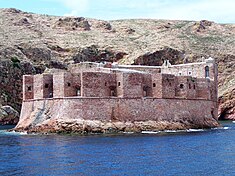Fort of São João Baptista (Berlengas)
| Fort Saint John the Baptist (Forte de São João Baptista) | |
| Fort of São João Baptista das Berlengas, Fort of the Berlenga | |
| Fort (Forte) | |
| Official name: Forte de São João Baptista das Berlengas | |
| Named for: John the Baptist | |
| Country | |
|---|---|
| Region | Centro |
| Sub-region | Oeste |
| District | Leiria |
| Municipality | Peniche |
| Location | Berlenga Grande |
| - coordinates | 39°24′40.46″N 9°30′36.42″W / 39.4112389°N 9.5101167°WCoordinates: 39°24′40.46″N 9°30′36.42″W / 39.4112389°N 9.5101167°W |
| Length | 45.35 m (149 ft), West-East |
| Width | 62.15 m (204 ft), North-South |
| Architects | Mateus do Couto |
| Materials | Masonry, Pink granite, Pavement, Wood, Glass, Concrete |
| Initiated | c. 1502 |
| - Constructed | c. 1651 |
| - Completed | c. 1678 |
| Owner | Portuguese Republic |
| For public | Private |
| Visitation | Closed |
| Easiest access | Berlenga Grande |
| Management | Instituto Gestão do Patrimonio Arquitectónico e Arqueológico |
| Operator | Câmara Municipal de Peniche, Associação dos Amigos da Berlenga |
| Status | National Monument |
| Listing | Decree 28/536; DG66, 22 March 1938 |
The Fort of São João Baptista das Berlengas, or simply known as the Fort of the Berlengas, is located off western coast of Portugal, on the largest island of the archipelago of the Berlengas, in the municipality of Peniche in Oeste region. The fortification belonged to a group of defensive military structures meant to protect the municipality located on the coast.
King Manuel of Portugal ordered the construction of a fortress on Berlenga Grande in 1502, which was immediately rectified under the reign of King Sebastian of Portugal. The fort, was constructed from the remains of a pre-existing monastery (the Monastery of the Misericórdia da Berlenga) which had previously been abandoned. Hieronymite monks had in the early 16th century, decided that the Berlengas were well situated to provide aid for seafearing people in need of shelter. The islands isolation also provided ideal conditions for the monks to live in austerity through solitude and silence, assiduous prayer and healthy penance. But, the monks became victims of frequent attacks by Algerian, Moroccan, English, and French pirates and privateers. Further, violent weather often cut-off communication to the mainland, which was especially distressing during pirate incursions, as result, the Monastery was abandoned.
It was only during the middle of 17th century that construction began, under the administration of John IV of Portugal, after the visit of João Rodrigues de Sá to the island, who, accompanied by a military engineer determined the plan to follow in its construction (in 1651). Originally during the Portuguese Restoration War, the Counsel of War had determined that a better coastal defense was needed, and had ordered the demolition of the monastery ruins to build the fort. By 1666 construction of the fort had proceed under the direction of engineer Mateus do Couto. That year the Fort of the Berlenga was instrumental in stopping the attack by a Spanish fleet, which was sent to kidnap Queen Maria Francisca of Savoy, on her arrival in Portugal, when she was to married to King Afonso VI of Portugal. After this attack, the King ordered the repair of the fortress, increasing the firepower of its defenses. Following its destruction by Spanish corsairs in 1666, it was finally completed in 1678 under the command of General Marquess da Fronteira (from an inscription over a gate).
...
Wikipedia

